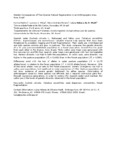Please use this identifier to cite or link to this item:
http://www.alice.cnptia.embrapa.br/alice/handle/doc/511241| Title: | Genetic consequences of tree species natural regeneration in an anthropogenic area, Acre, Brazil. |
| Authors: | MARTINS, K.  RIBAS, L. A.   MORENO, M. A.   WADT, L. H. de O.   |
| Affiliation: | KARINA MARTINS, Universidade Federal de São Carlos LUCIANO ARRUDA RIBAS, CPAF-AC MARIA ANDRÉIA MORENO, Escola Superior de Agricultura Luiz de Queiroz LUCIA HELENA DE OLIVEIRA WADT, CPAF-AC. |
| Date Issued: | 2008 |
| Citation: | In: WORKING FORESTS IN THE TROPICS, 2008, Gainesville. Partnering research with pratice for conservation and developement: abstract book and program. Gainesville: University of Florida, 2008. |
| Pages: | 1 p. |
| Description: | Spanish cedar (Cedrela odorata L., Meliaceae) and Yellow poui (Tabebuia serratifolia Nichols., Bignoniaceae) are economically valuable tropical tree species that have been threatened by predatory logging and forest fragmentation. Their seeds are wind-dispersed and both species colonize and grow in pastures. This study compared the genetic diversity of a 30 year pasture-established population to a forest population, located five km apart from each other in Rio Branco, Acre, Brazil. |
| Thesagro: | Regeneração Natural |
| Keywords: | Espécies arbóreas Diversidade genética Cedro espanhol Cedrela odorata L Ipê amaraelo Tabebuia serratifolia Nichols Rio Branco (AC) Acre Amazônia Ocidental |
| Type of Material: | Resumo em anais e proceedings |
| Access: | openAccess |
| Appears in Collections: | Resumo em anais de congresso (CPAF-AC)  |










